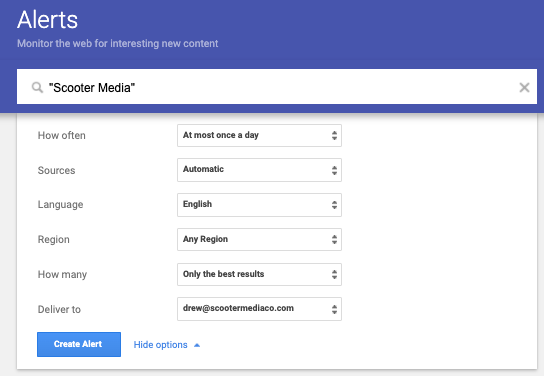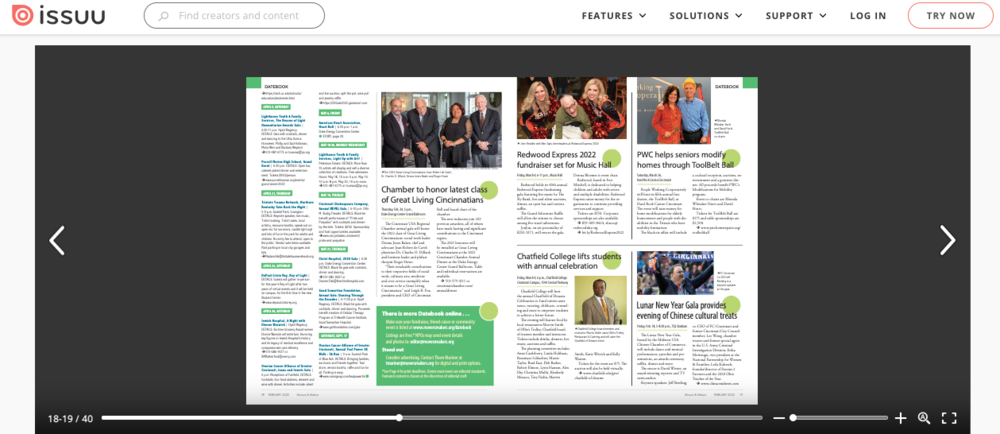Whether you’re handling the PR for a major organization or a small business, tracking media coverage is an essential part of any professional communicator’s toolbox. Closely monitoring what news organizations and social media users are saying gives your organization the ability to proactively participate in discussions and understand how key audiences are perceiving your brand.
However, with thousands of news outlets publishing content every single day and a seemingly infinite number of social media audiences contributing to the discussion, tracking media coverage is more difficult than ever. But fear not — there are several tools that are invaluable in helping PR pros stay on top of story placements.
Here are a few of our favorite free and easy options for tracking media coverage:
#1: Google Alerts

One of the easiest — and best — ways to start tracking media coverage is to set up Google Alerts. Using Google Alerts, you can insert key terms and phrases (such as the name of your brand or business), and as those terms are mentioned in online news outlets, Google will send notifications of those mentions directly to your email.
Google Alerts also offers several filters so that you can customize the tool, the most notable being the ability to choose how often you receive emails and the types of news sources you want to be monitored. For example, if you aren’t interested in tracking blog mentions, you can choose to opt-out of receiving those notifications.
While Google Alerts is a great starting point, it should be noted that the tool isn’t a perfect science, and likely will not catch every mention of your brand. With that in mind, we recommend pairing Google Alerts with another tool, along with manually searching for placements that Google Alerts may have missed.
#2: Talkwalker
Talkwalker bills itself as a “consumer intelligence platform,” allowing brands to monitor and track conversations so that they are able to respond strategically and get a more thorough understanding of how their organization is being perceived. While there are paid versions of Talkwalker that offer more extensive tools, the platform also offers two free services: Talkwalker Alerts and Talkwaker Social Search.
Talkwalker Alerts is a free system that can track your brand’s keywords through not only websites, blogs, and forums, but also Twitter. These Alerts pull the most important conversations involving your brand and send them directly to your inbox to help you stay informed. Similar to Google Alerts, you can also add specific filters to customize your results, ensuring that you receive the most relevant information.
The second free tool offered by the platform is Talkwalker Social Search. This simple but powerful tool allows you to track mentions of your brand across all major social media platforms, giving you the power to keep up with conversations in real-time. This tool also gives brands the option to track the social media activity of up to four top competitors and compare that activity to their own.
#3: Bookmark Key Websites and Outlets
Which news outlets talk about your organization most frequently? If there are certain publications or journalists known for covering topics that involve your brand, it’s a good idea to bookmark the websites their pieces are published to so that you can have easy access to those stories. These manual searches can be easily combined with Google Alerts or Talkwalker to ensure that all media placements are gathered, including placements those tools may have missed.
TIP: If the media outlets you’re searching for have print and digital versions, don’t forget to bookmark both! Many publications offer digitized versions of their print publications through services such as Issuu, which are important places to manually check as they are not always caught by automated tools.

#4: Reach Out to Journalists
Reaching out to journalists to learn about a story’s development may seem old school, but it is still an effective way to track media coverage you know is coming. If you know a specific journalist is working on a piece that involves your brand, that journalist will (hopefully) be able to keep you updated on the story’s progress so you can continue to keep an eye out for its placement. (Just be sure to return the favor by publicizing the story on your organization’s social channels!)
While this method is likely not sustainable in the long run as your brand grows in size and reach, it is a surefire way to find out more information about the media coverage of your brand. This can still be applied to larger brands, but we recommend only doing it sparingly (or for key stories) because reaching out to too many journalists can become a time-consuming process.
There’s no doubt that tracking media coverage can be challenging even for experienced PR pros, but using a combination of these tools will help to ensure you’re not missing the important discussions happening about your brand online. If you’ve got a favorite media tracking tool or tip to share, let us know by tweeting us at @ScooterMedia!
Searching for more tips? Check out “3 Tools for PR Project Management,” then discover “6 Tips for Making the Most Out of Your PR Placement.”


